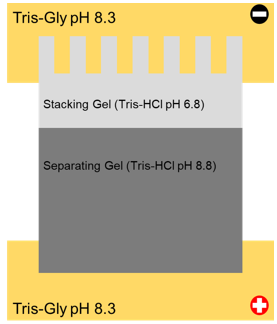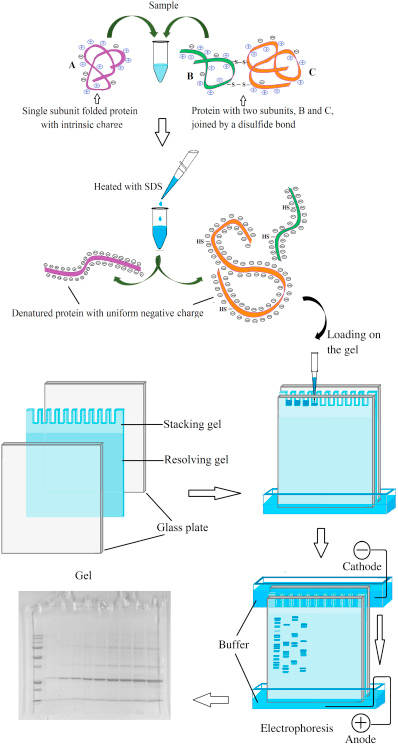How to Read a Sds Page Gel
How Does SDS-Folio Work?
Electrophoresis is a major technique for separating proteins and other substances such every bit nucleic acids, purines, pyrimidines, some organic compounds and even inorganic ions. Most of the electric current electrophoresis is to split up the sample into the mobile phase in an immobilized medium. Polyacrylamide gel is one of the main media. It is a porous gel whose pore size is close to the size of protein molecules, which improves the resolution of proteins. Moreover, the polyacrylamide gel has good chemical stability, stiff repeatability, stability to changes in pH and temperature, and easy color observation. SDS polyacrylamide gel electrophoresis (SDS-PAGE) has the advantages of simple operation and expert reproducibility in the determination of protein molecular weight, detection of specific proteins, and identification of strain species.
The Principle of SDS-Folio
Polyacrylamide gel is equanimous of acrylamide and cantankerous-linking agent N, Northward'-methylenebisacrylamide under the activeness of catalysts ammonium persulfate (AP) and N, N, N', Due north'-Tetramethylethylenediamine (TEMED). It is a gel with a three-dimensional network structure. PAGE tin can separate proteins into several bands according to the different mobility caused by the different charge and molecular weight of protein molecules. SDS is an anionic surfactant, which can break the hydrogen and hydrophobic bonds of proteins in the presence of reducing agents (β-mercaptoethanol or dithiothreitol, DTT), and combine with poly peptide molecules in a certain ratio to form short rod-shaped composites of the aforementioned density. Positively correlated with the molecular weight of the protein, the length of the complex formed by proteins of different molecular weights is unlike. SDS makes the amount of negatively charged protein far exceed its original accuse, masking the natural charge difference betwixt various poly peptide molecules. Therefore, the mobility of various protein-SDS complexes during electrophoresis is no longer afflicted by the original charge and molecular shape, but only depends on the relative molecular mass.
 The polyacrylamide gel is ordinarily composed of a stacking gel in the upper layer and a separating gel in the lower layer. The difference between the upper and lower gels is the concentration of acrylamide and the pH of Tris-HCl. During electrophoresis, an electrical field is applied to the gel, and negatively charged proteins migrate across the gel from the negative electrode to the positive electrode. The almost common electrophoresis buffer consists of Tris and glycine. The pH in the stacking gel is 6.8, and only a few glycine molecules dissociate. Therefore, the SDS-treated poly peptide molecules move between the upper glycine molecule and the lower Cl- ion. This process compresses the protein sample in the gel into bands that are much smaller than the volume initially loaded. As the electrophoresis progresses, the protein moves to the separating gel (pH 8.8), where of the glycine molecules dissociate. The speed of the motility increases and exceeds the poly peptide. In the separating gel, the speed of movement of each protein depends on its molecular weight. Proteins with modest molecular weights can laissez passer through the pores in the gel easily, while those with large molecular weights accept more difficulty passing through. Later on a menses of time, proteins reach different distances co-ordinate to the sizes, achieving the purpose of poly peptide separation.
The polyacrylamide gel is ordinarily composed of a stacking gel in the upper layer and a separating gel in the lower layer. The difference between the upper and lower gels is the concentration of acrylamide and the pH of Tris-HCl. During electrophoresis, an electrical field is applied to the gel, and negatively charged proteins migrate across the gel from the negative electrode to the positive electrode. The almost common electrophoresis buffer consists of Tris and glycine. The pH in the stacking gel is 6.8, and only a few glycine molecules dissociate. Therefore, the SDS-treated poly peptide molecules move between the upper glycine molecule and the lower Cl- ion. This process compresses the protein sample in the gel into bands that are much smaller than the volume initially loaded. As the electrophoresis progresses, the protein moves to the separating gel (pH 8.8), where of the glycine molecules dissociate. The speed of the motility increases and exceeds the poly peptide. In the separating gel, the speed of movement of each protein depends on its molecular weight. Proteins with modest molecular weights can laissez passer through the pores in the gel easily, while those with large molecular weights accept more difficulty passing through. Later on a menses of time, proteins reach different distances co-ordinate to the sizes, achieving the purpose of poly peptide separation.

Effigy i. Schematic diagram of polyacrylamide gel electrophoresis (Gülay, et al, 2018).
How to Determine Molecular Weight of Protein past SDS-PAGE?
SDS-Folio is the main method to determine the molecular weight of unknown proteins. A protein with known molecular weight and an unknown sample are electrophoresed at the same time. After staining, according to the relative mobility of the standard protein and the logarithm of the molecular weight, a line tin be obtained and determine the molecular weight of the unknown sample using its relative mobility. In the laboratory, a standard molecular weight protein covalently coupled to a dye is used every bit a reference poly peptide to roughly betoken the size of the unknown protein. This pre-stained protein marker can be directly observed during electrophoresis or when transferring membranes.
How to Read SDS-Folio Results?
Later on electrophoresis, protein separation cannot be straight observed past the naked eye, and subsequent staining techniques are needed. Coomassie vivid blue staining and argent staining are common methods for routine detection and quantification of proteins separated past electrophoresis. After simple processing such as fixation-staining-decolorization, the distribution of poly peptide can be clearly observed. With the comeback of high-sensitivity poly peptide analysis methods and protein identification technologies, new staining methods such as fluorescent labeling and isotope labeling applied science have greatly improved sensitivity, and are also uniform with automated proteome platform gel cutting technology. More than high sensitivity and automated dyeing technologies are been developed.
How to Store SDS-PAGE Gel?
Freshly SDS-PAGE gels are usually prepared before each experiment. However, gels tin besides be stored in clean water at 4°C for about a week. If the gel cannot be photographed in time afterward dyeing, information technology needs to be placed in water to prevent drying and shrinking of the gel. It is brash to photograph the staining results as soon equally possible. Band will disperse if the gel is soaked in h2o for a long time.
References
one. Smith B J. SDS Polyacrylamide Gel Electrophoresis of Proteins. Methods in Molecular Biology, 1984, 1(4):41-55.
2. Duffy M F, Noormohammadi A H, Baseggio N, et al. Polyacrylamide gel-electrophoresis separation of whole-cell proteins. Methods in Molecular Biology, 1998, 104:267.
* For Enquiry Use Only. Non for employ in diagnostic procedures.
Our customer service representatives are available 24 hours a day, 7 days a week. Research
Online Inquiry
Please submit a detailed description of your project. We will provide you with a customized project plan to run into your enquiry requests. You tin also send emails directly to for inquiries.
Source: https://www.creative-proteomics.com/resource/how-does-sds-page-work.htm
0 Response to "How to Read a Sds Page Gel"
Post a Comment